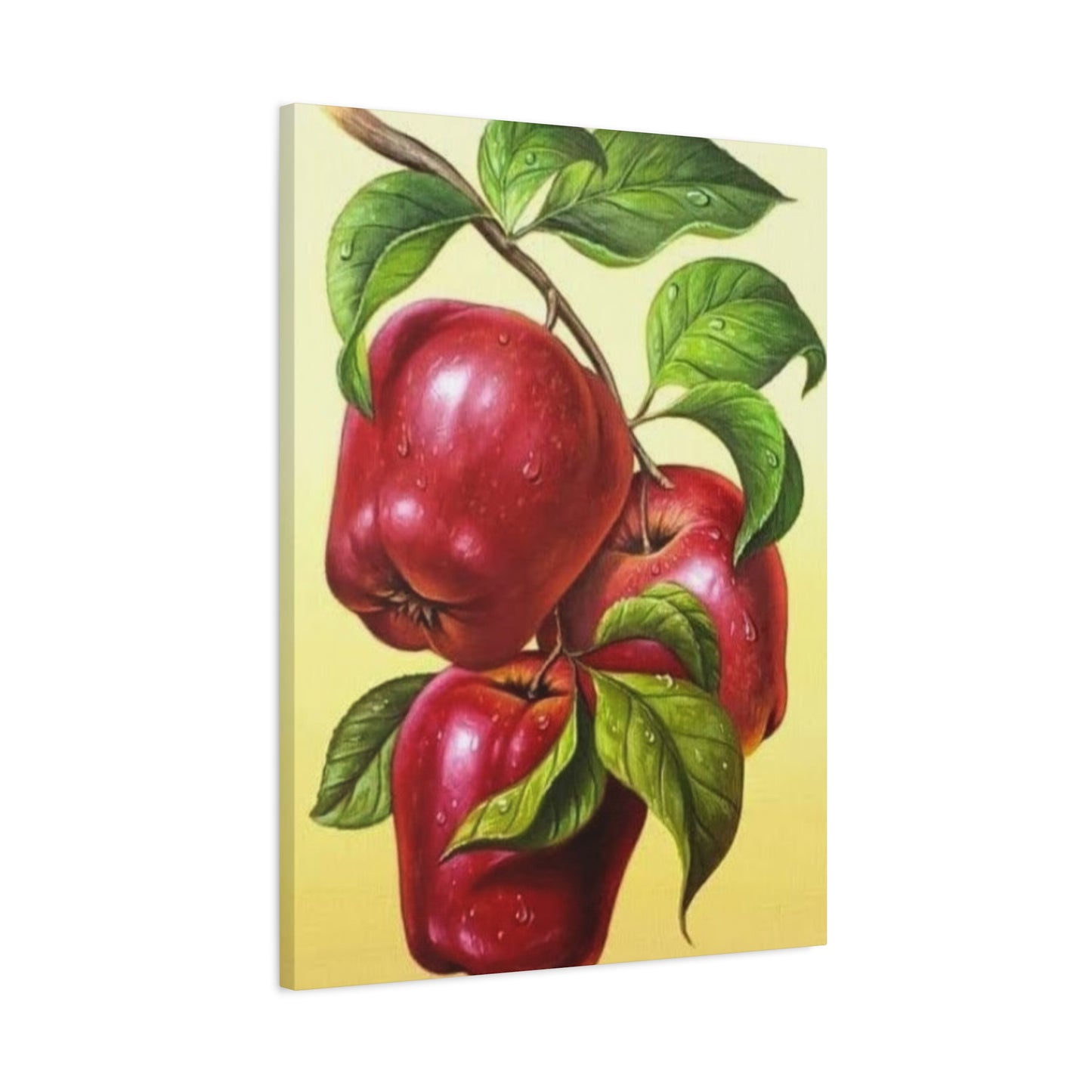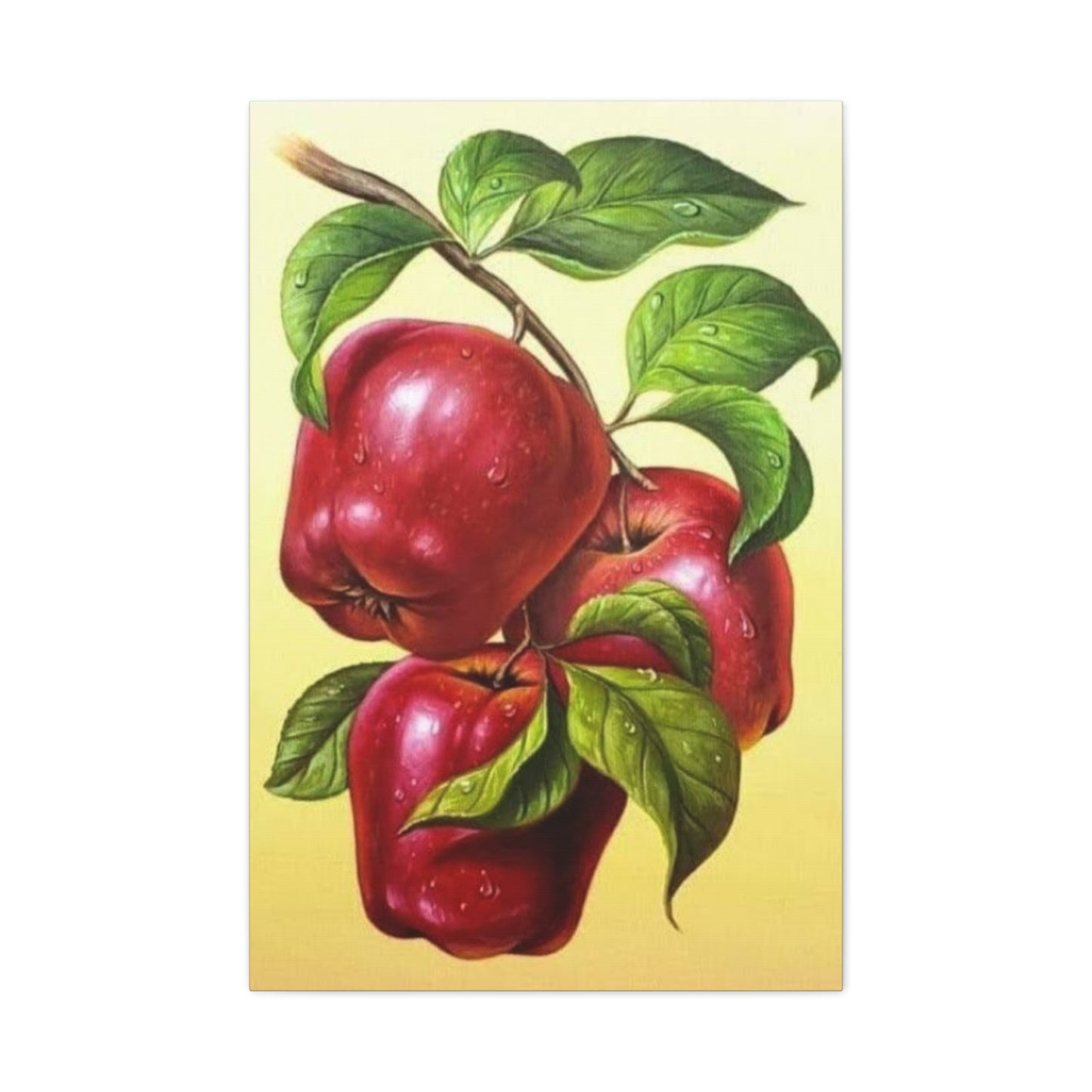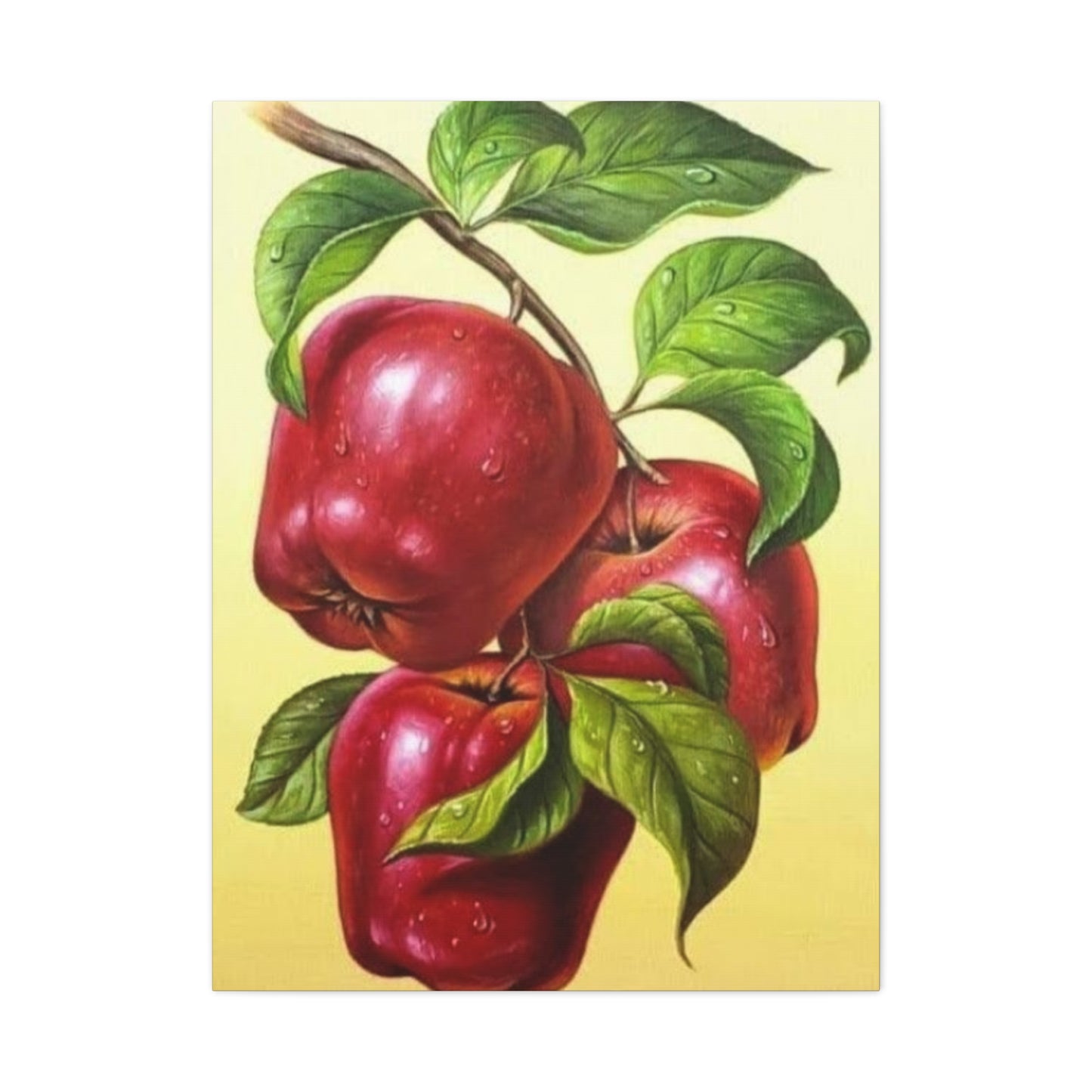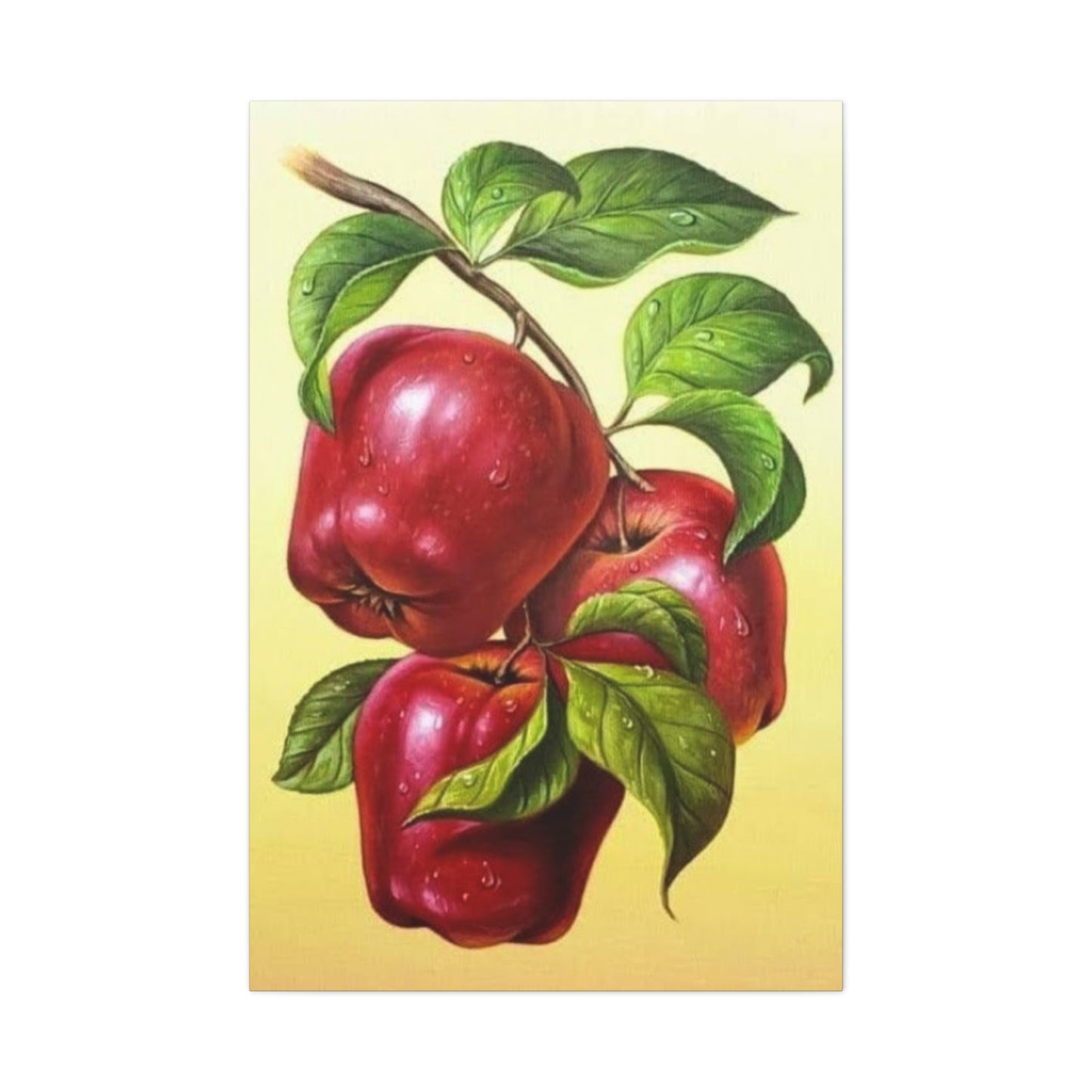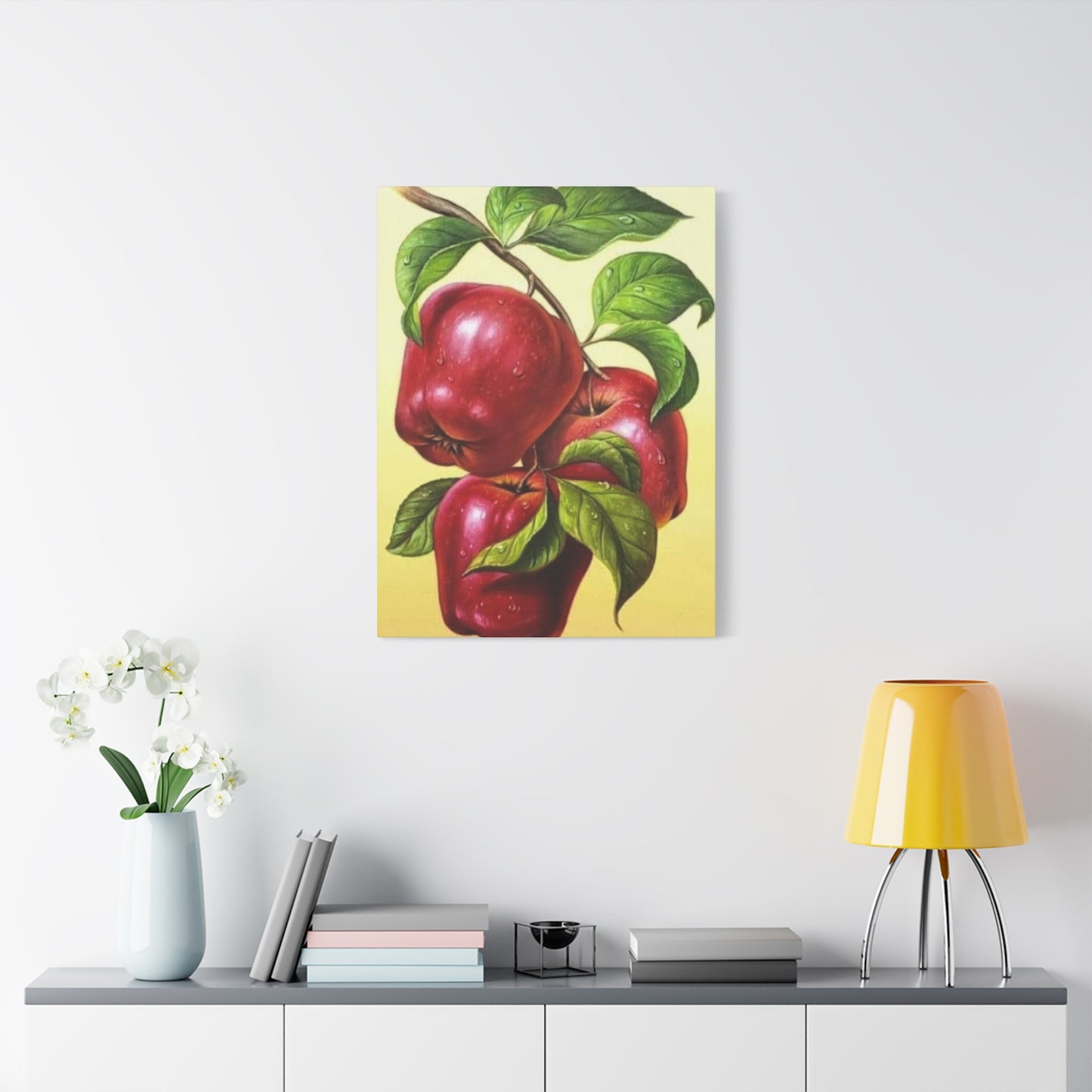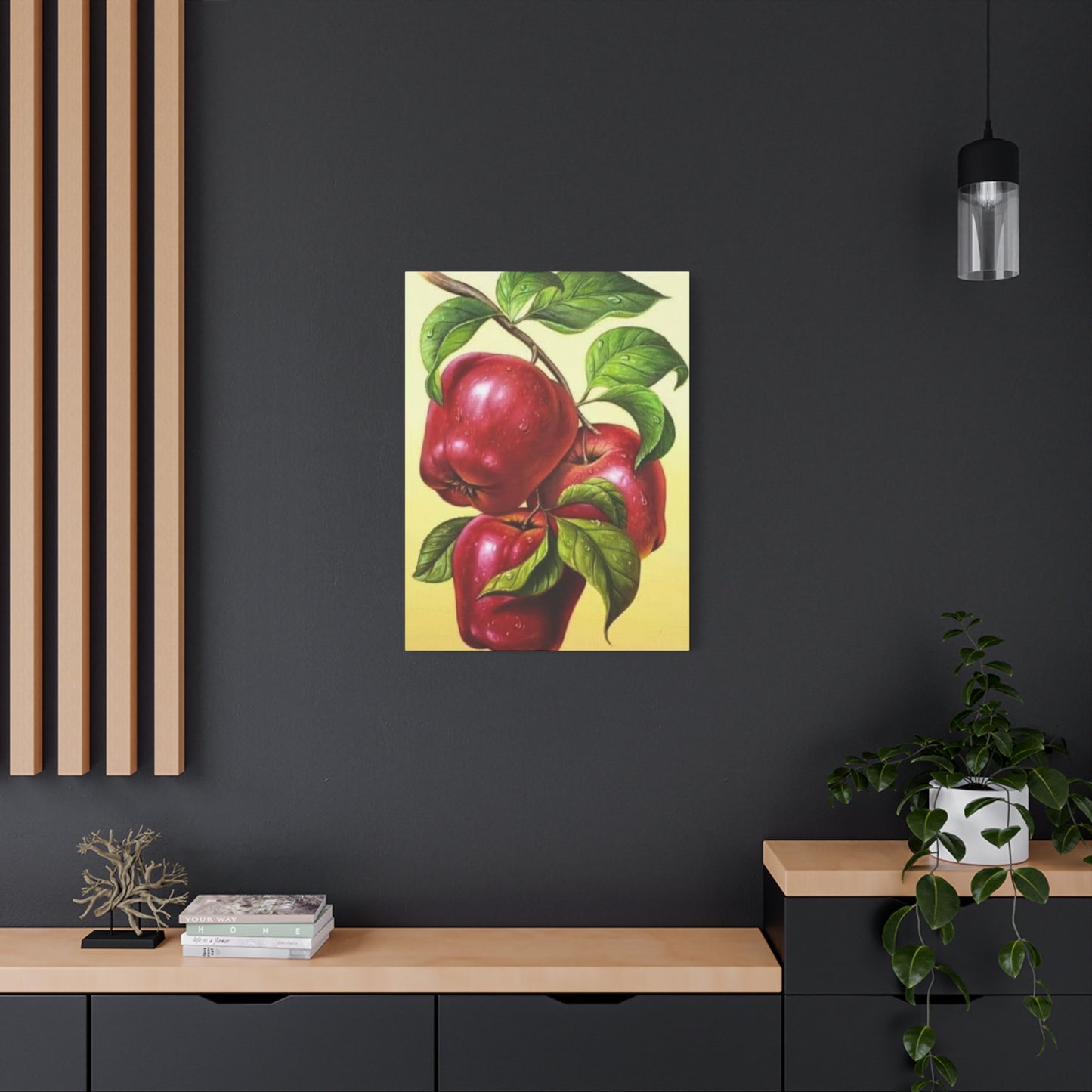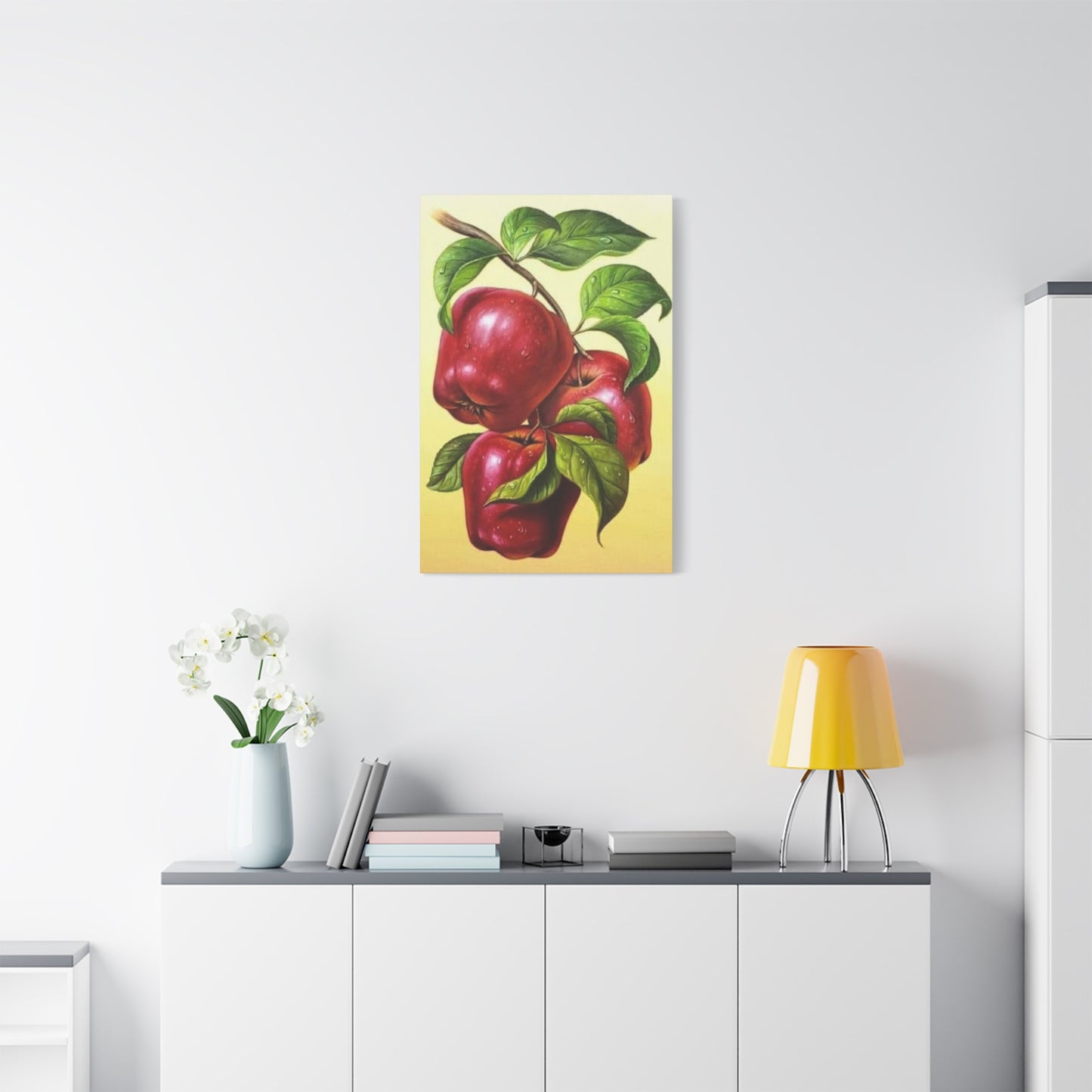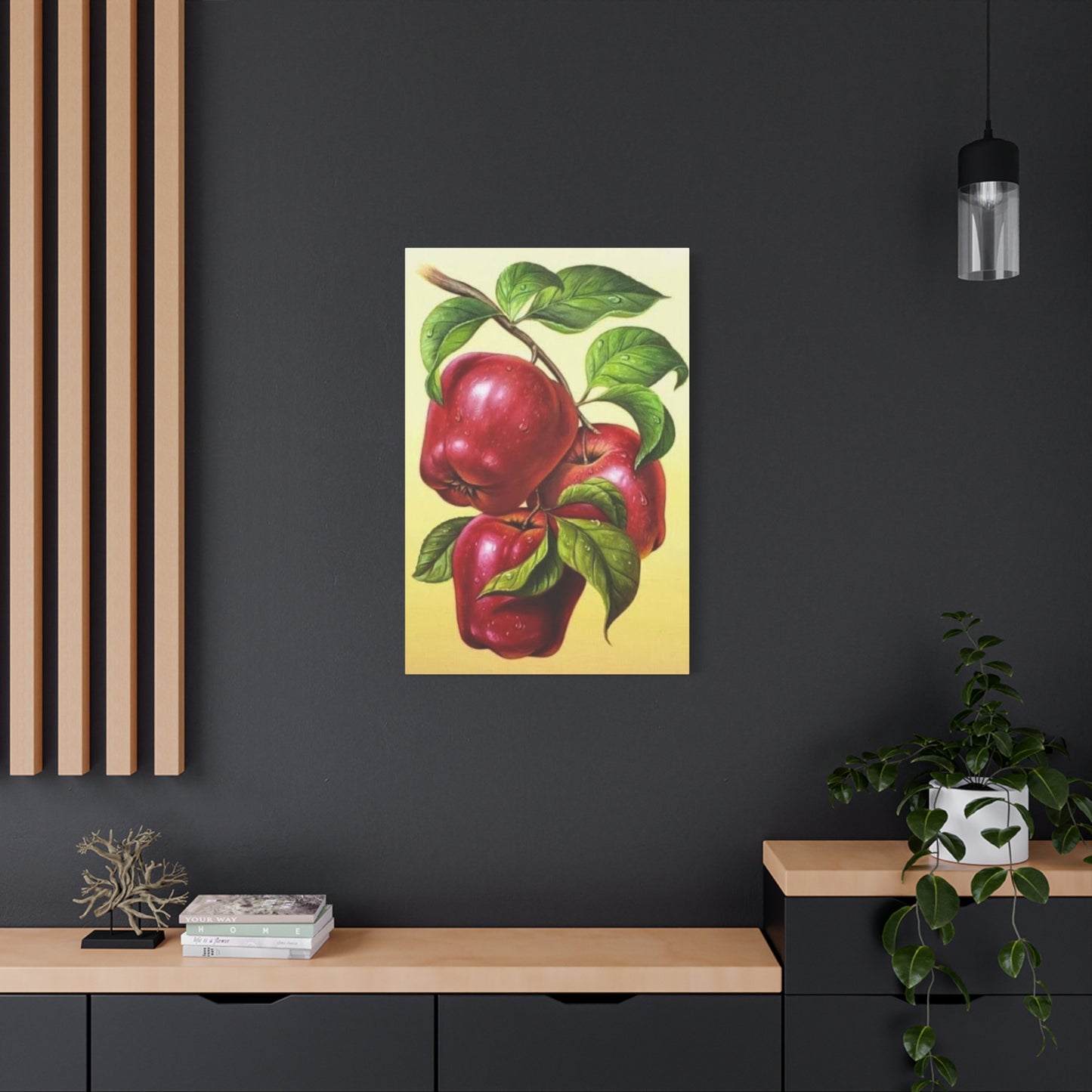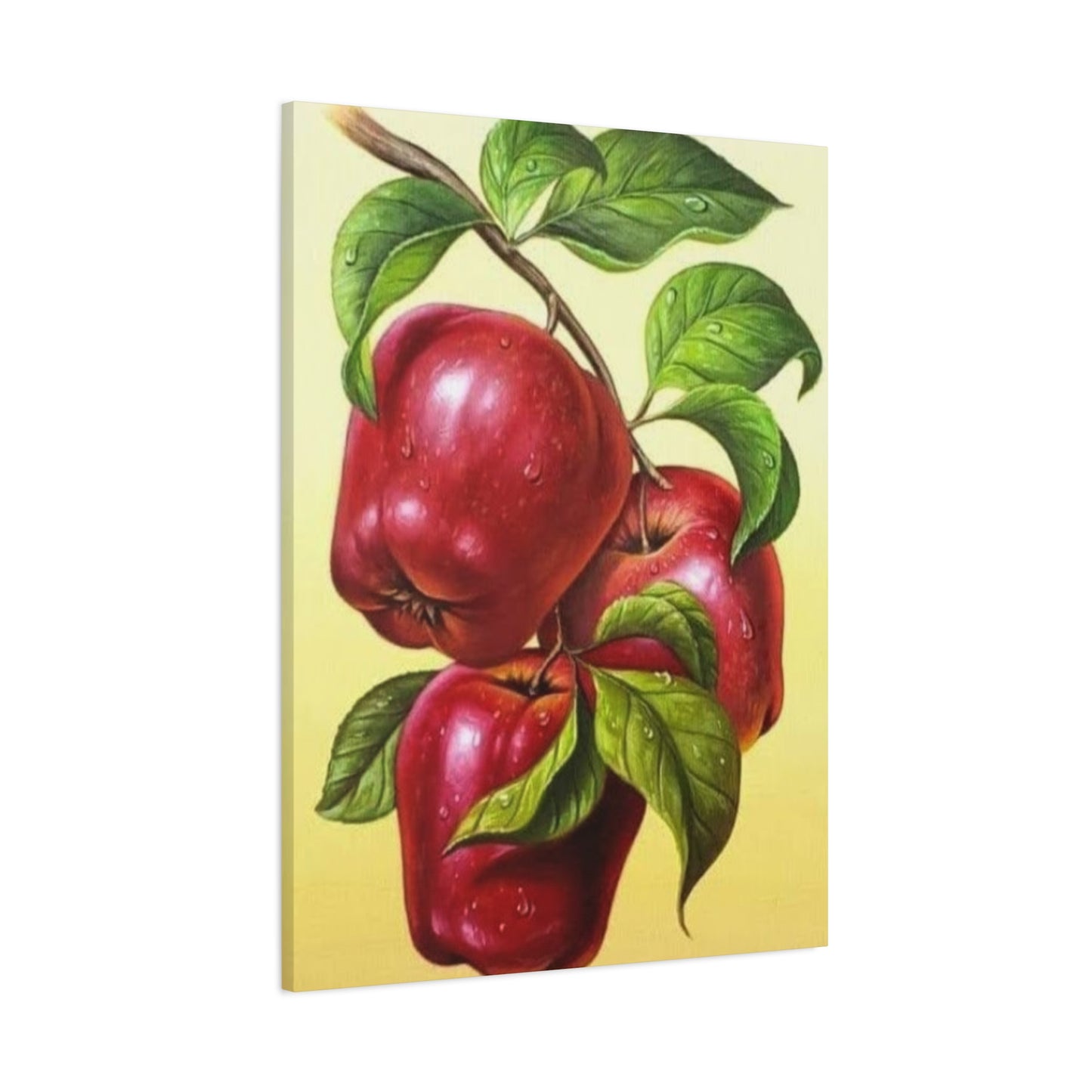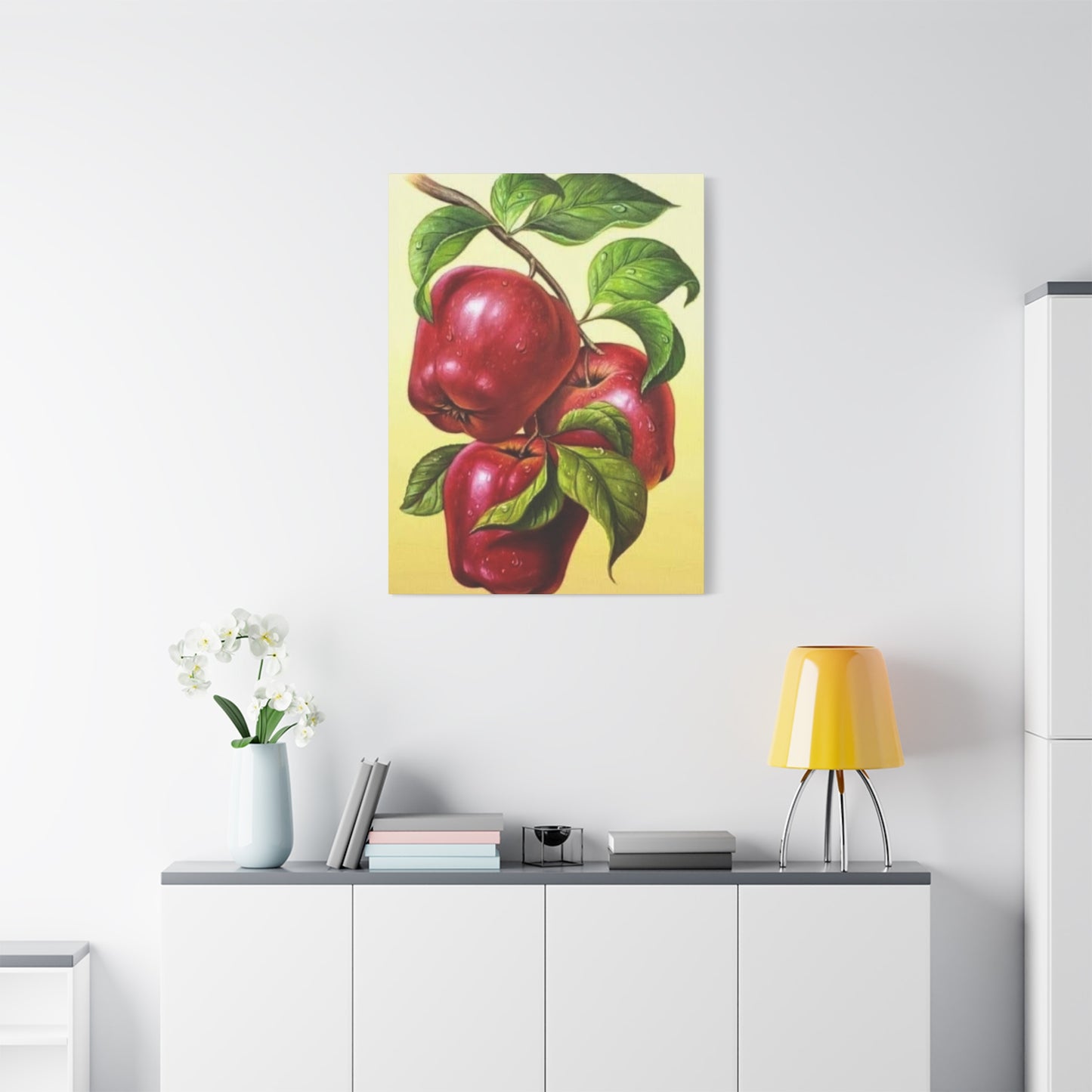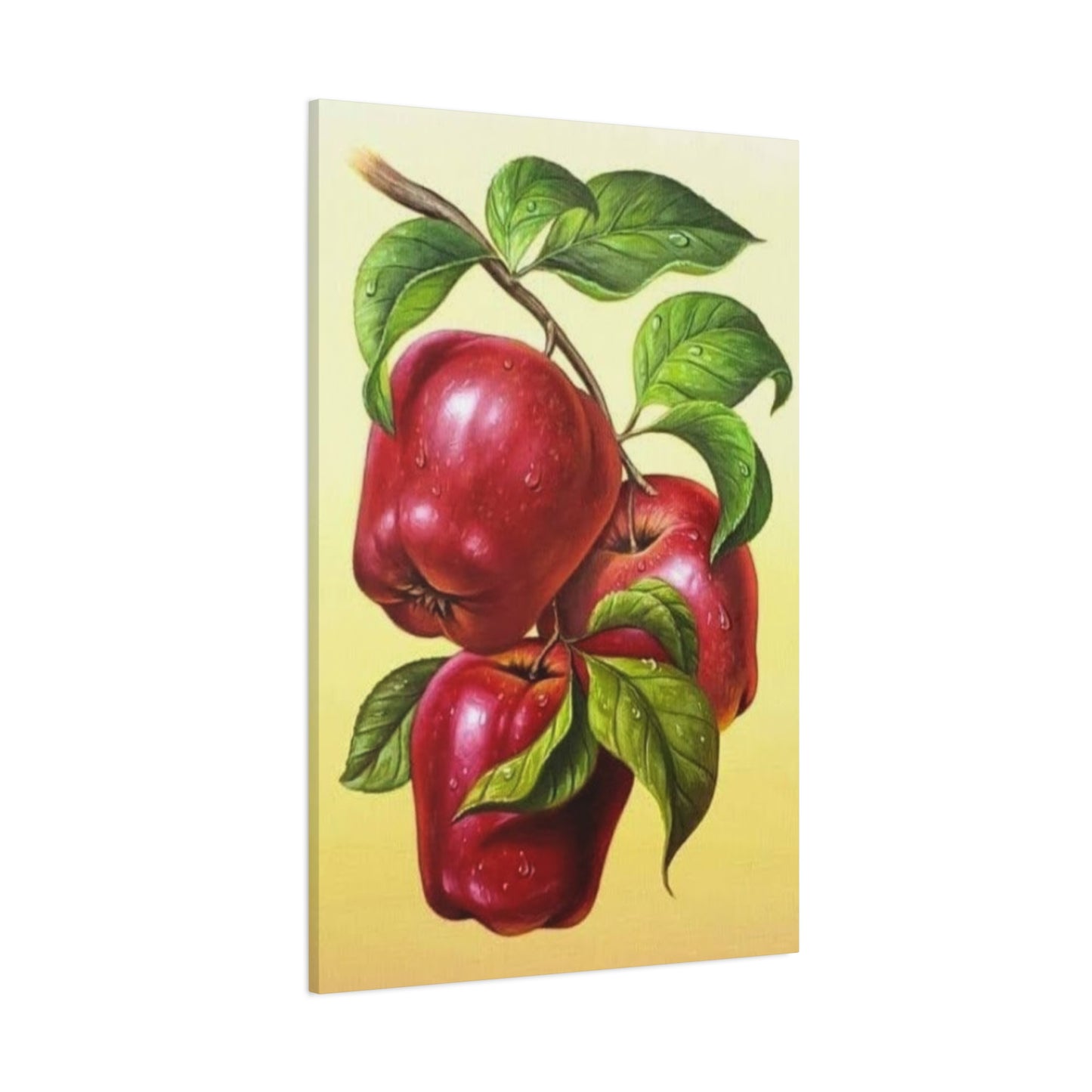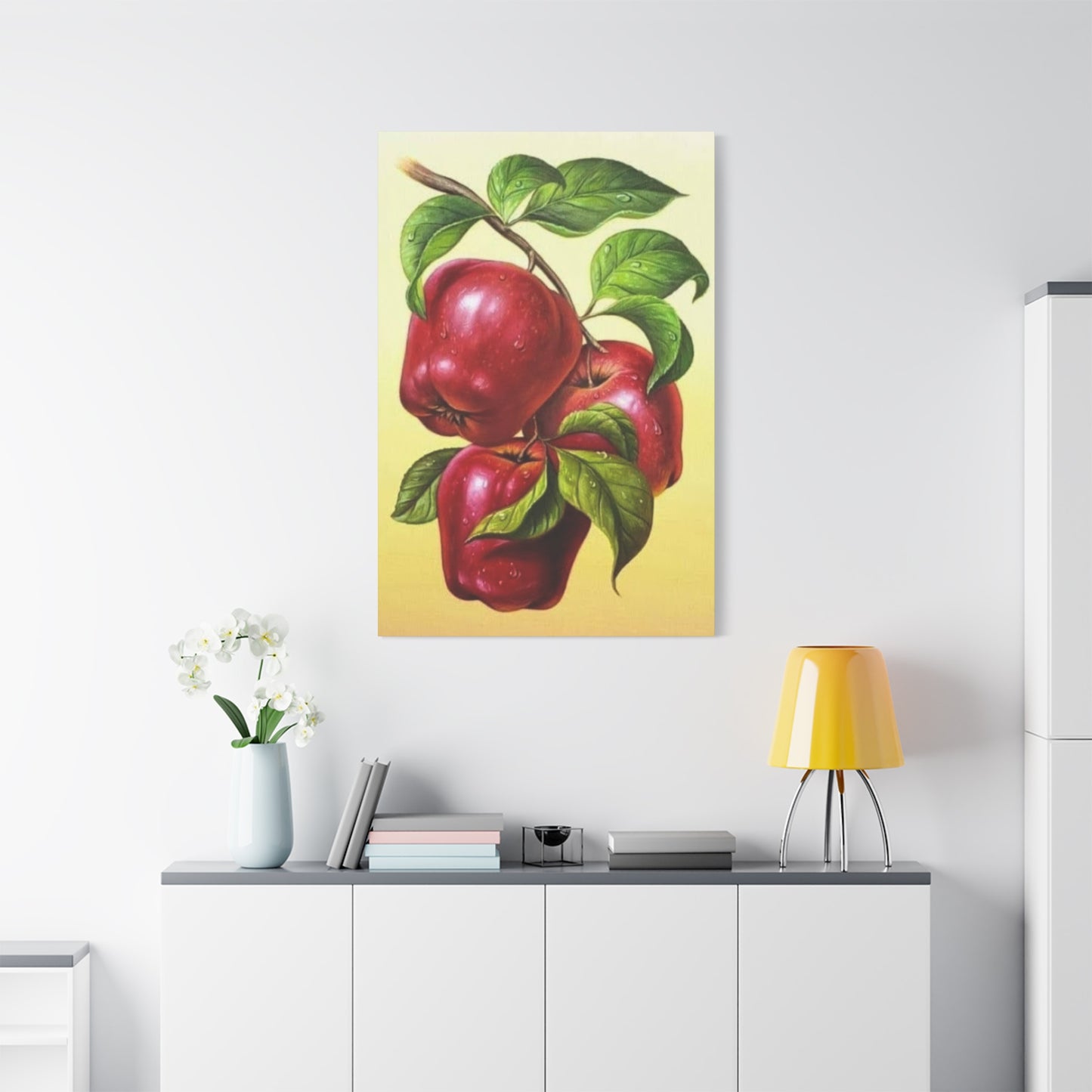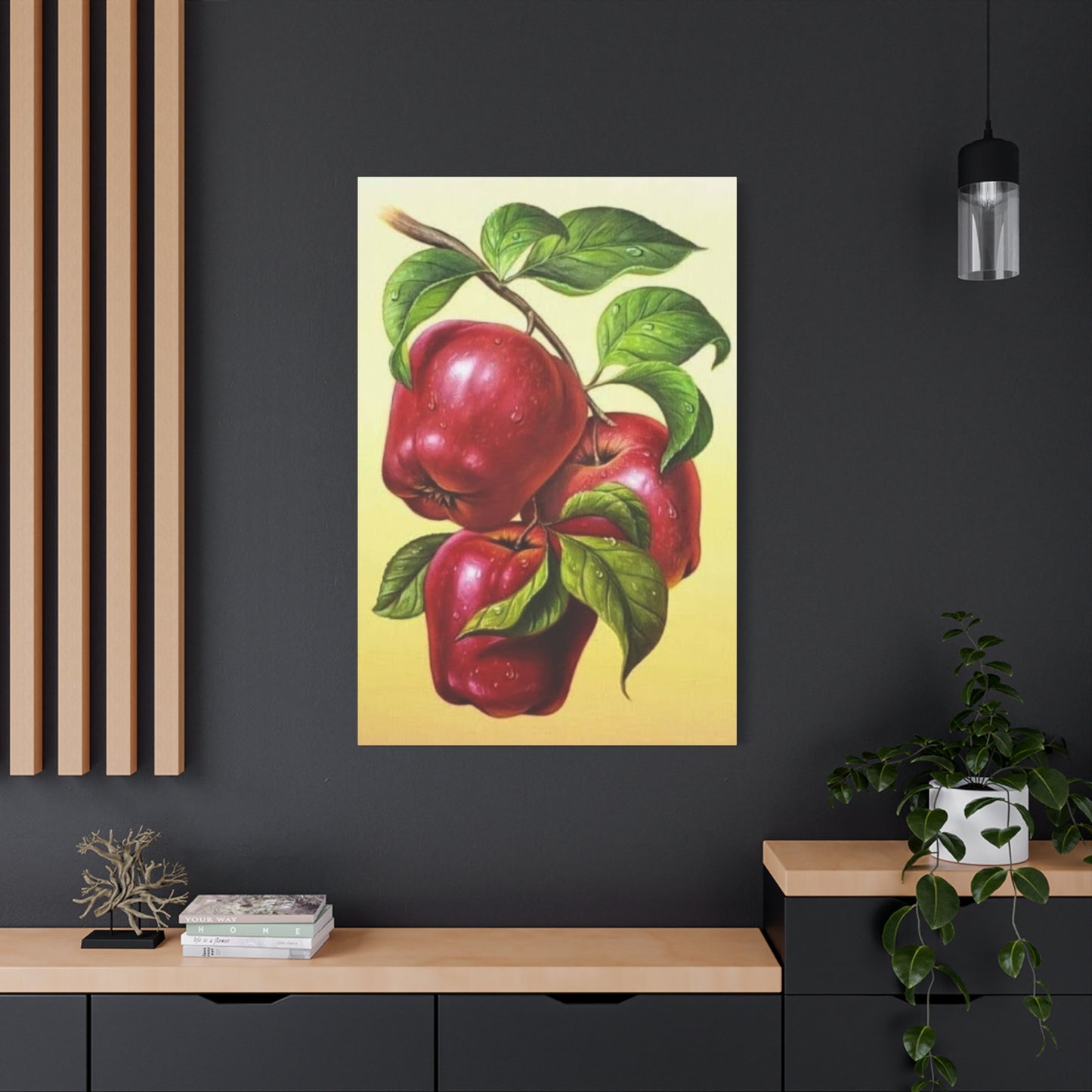The Enduring Allure of Red Apple Wall Art: A Deep Dive into Canvas Prints
The simple, humble apple has captivated artists for centuries. Its smooth, taut skin, the gentle curve of its form, and its vibrant coloration make it a perfect subject for visual exploration. When this timeless muse is rendered in a brilliant, striking red and presented on high-quality canvas, it becomes more than just a depiction of fruit; it transforms into a powerful statement piece for any room. Red apple wall art canvas prints offer a unique blend of natural simplicity and potent symbolism, making them a versatile and compelling choice for home adornment. This exploration delves into every facet of these remarkable artworks, from their deep historical and symbolic roots to the technical aspects of the canvas medium itself.
We will journey through various artistic styles, discover how to harmoniously integrate these pieces into your living environment, and understand the profound psychological impact they can have. The subject of a red apple on canvas is not merely decorative; it is a conversation starter, a mood enhancer, and a timeless link to both nature and the long, rich history of art. It speaks of vitality, knowledge, health, and temptation, all while providing a stunning visual anchor that can unify and elevate a room's atmosphere. Whether presented as a single, hyper-realistic specimen or as part of an abstract composition, the red apple in art remains an icon of undeniable power and beauty.
The Timeless Appeal of Red Apples in Visual Culture
The image of a red apple is universally recognized, evoking a cascade of associations that are deeply embedded in our collective consciousness. This is not a recent phenomenon; the apple has been a recurring motif in visual culture for millennia, representing a spectrum of ideas from love and fertility to wisdom and discord. Its consistent presence in art is a testament to its powerful symbolic resonance and its simple, yet perfect, aesthetic form. The very shape of an apple is pleasing to the eye—a sphere that is almost, but not quite, perfect, with its characteristic indentations at the stem and blossom ends. This subtle imperfection gives it character and a natural, organic quality that artists find endlessly fascinating. The color red adds another layer of complexity, as red is the color of passion, energy, life, and warning.
A red apple, therefore, is never just a red apple. It is a condensed symbol, a visual shorthand for a host of powerful human emotions and stories. Red apple wall art canvas prints tap into this deep well of cultural significance, allowing us to bring a piece of this rich visual history into our own homes. The appeal is timeless because the themes the apple represents—health, temptation, nature’s bounty, and the cycle of life—are themselves timeless. It is an image that feels both classic and contemporary, capable of fitting into a rustic farmhouse setting as comfortably as it does in a sleek, modern apartment. This versatility is a key component of its enduring charm.
Historical Significance of Apples in Artistic Representation
To fully appreciate red apple wall art canvas prints, one must look back at the apple's long and storied journey through the annals of art history. The fruit's role as a potent symbol began in ancient mythologies. In Greek lore, the Golden Apple of Discord, inscribed "for the fairest," ultimately led to the Trojan War, cementing the apple's association with choice, conflict, and fateful beauty. Norse mythology features the apples of Iðunn, which grant the gods eternal youth, linking the fruit to vitality and longevity. However, its most famous role is undoubtedly in the Judeo-Christian narrative of the Garden of Eden, where it becomes the forbidden fruit from the Tree of Knowledge of Good and Evil.
Although the Bible never specifies the fruit is an apple, European artistic tradition, particularly during the Renaissance, firmly established it as such. Artists like Albrecht Dürer and Lucas Cranach the Elder depicted Adam and Eve with a gleaming apple, forever associating it with temptation, sin, and the dawn of human consciousness. Later, during the Dutch Golden Age, the apple became a staple of still life paintings, or vanitas, where it often symbolized earthly pleasures and the fleeting nature of life. The meticulous rendering of a perfect, ripe apple next to a wilting flower or a skull served as a poignant reminder of mortality. This rich and varied history infuses every modern depiction, lending a sense of depth and narrative to what might otherwise be a simple decorative object.
The Red Apple as a Symbol of Life and Vitality
Beyond its more complex historical connotations, the red apple stands as a powerful and unambiguous symbol of life, health, and vitality. Its crisp texture, juicy flesh, and vibrant, blood-red skin are intrinsically linked to concepts of energy and well-being. This connection is reinforced by the age-old adage, "an apple a day keeps the doctor away," a piece of folk wisdom that has cemented the fruit's reputation as a cornerstone of a healthy lifestyle. When this symbolism is translated onto a canvas print, it can infuse a room with a sense of vigor and freshness. A piece of red apple wall art in a kitchen or dining area acts as a visual celebration of nourishment and wholesome living. The image of a perfect, ripe apple suggests nature's bounty and the simple, life-sustaining pleasures of food.
The color red itself is biologically stimulating; it is known to increase heart rate and energy levels, making it a dynamic addition to any decorative scheme. A canvas print featuring a glistening red apple, perhaps with a single drop of water on its skin, speaks of freshness, hydration, and the fundamental forces of nature. It serves as a daily reminder of the simple goodness that sustains us, making it an uplifting and positive artistic choice for any environment dedicated to family, food, and fellowship. It is a celebration of life in its most elemental and beautiful form.
Symbolism of Temptation and Knowledge Associated with Red Apples
The duality of the red apple is one of its most compelling attributes. While it represents health and life, it also carries the much darker, more complex symbolism of temptation and forbidden knowledge. This association stems directly from its portrayal as the forbidden fruit in the story of Adam and Eve. In this context, the apple is not an object of nourishment but one of desire, disobedience, and the loss of innocence. It represents a pivotal moment of choice, the pursuit of knowledge at a great cost. This layer of meaning adds a dramatic tension and intellectual depth to red apple artwork. A canvas print depicting a single, luminous red apple against a dark, moody background can feel alluring and slightly dangerous.
It invites contemplation about the nature of desire, the consequences of our choices, and the eternal human quest for understanding. This symbolic weight prevents the artwork from being merely pretty; it gives it a narrative edge and a philosophical resonance. Displaying such a piece can reflect a personality that appreciates complexity, embraces intellectual curiosity, and is not afraid to explore the more mysterious aspects of the human condition. It becomes a sophisticated artistic statement, suggesting that beauty is often intertwined with risk, and that the most profound experiences in life often come from daring to reach for what is forbidden.
Apples Representing Health and Wellness in Visual Art
The connection between apples and well-being is a theme that artists have explored in various ways, making it a particularly suitable subject for environments focused on health. Beyond the simple proverb, the apple visually embodies the very concept of wholesomeness. Its round, full shape suggests completeness and satiety, while its unblemished skin speaks of purity and natural perfection. In visual art, an apple is often used to signify a return to simple, natural living. A canvas print featuring a bowl of freshly picked red apples can evoke feelings of rustic simplicity and the farm-to-table ethos. It promotes a sense of grounding and a connection to the earth.
For this reason, red apple wall art canvas prints are an excellent choice for places like kitchens, dining rooms, fitness studios, or even a doctor's waiting room. The image acts as a positive affirmation, a visual cue that reinforces goals of healthy eating and self-care. It is a gentle yet persistent reminder of the benefits of making wholesome choices. The artwork does not preach; it simply presents an image of natural goodness, allowing the viewer to absorb its positive message subconsciously. This makes it a powerful decorative tool for creating an atmosphere that is not only aesthetically pleasing but also subtly supportive of a healthy and balanced lifestyle.
The Color Red: Psychology and Impact in Apple Artwork
The choice of a red apple is artistically significant due to the potent psychological effects of the color red. Red is the most emotionally intense color in the spectrum, capable of eliciting strong feelings and commanding attention. In the context of red apple wall art, this color works on several levels. First, it creates an immediate and powerful focal point. The eye is naturally drawn to red, so a canvas print featuring a vibrant red apple will instantly capture a viewer's gaze, making it an effective anchor in any room's decor. Second, red is associated with energy, passion, and excitement. It can invigorate a setting, making it feel more dynamic and alive. This is particularly useful in social areas like living rooms or dining areas, where it can stimulate conversation and interaction.
Third, red is known to stimulate the appetite, which is why it is so often used in the branding of food products and in the decoration of restaurants. This makes red apple canvas prints an especially fitting choice for any space related to eating. However, the impact of red depends on its specific shade and how it is used. A bright, fire-engine red apple can feel bold and modern, while a deeper, more crimson or burgundy apple can evoke a sense of richness, luxury, and tradition. The artist's handling of the color red is therefore crucial in determining the overall mood and impact of the artwork.
Cultural Variations in the Meaning of the Apple Symbol
While many of the apple's symbolic meanings are widespread, particularly those from Greco-Roman and Judeo-Christian traditions, its significance can vary across different cultures. Understanding these variations adds another layer of appreciation for red apple wall art. In Chinese culture, the word for apple, "píngguǒ" (苹果), sounds very similar to the word for peace, "píng'ān" (平安). For this reason, apples are often given as gifts to signify a wish for safety and harmony, making the fruit a symbol of good fortune and tranquility. Artwork featuring apples in this cultural context would evoke feelings of calm and goodwill rather than temptation. In Celtic traditions, the apple is associated with the Otherworld and immortality.
The mythical Isle of Avalon is literally the "Isle of Apples." An apple branch bearing fruit, flowers, and unopened buds was a magical artifact that allowed mortals to enter the realm of the gods. From this perspective, an apple in art could symbolize magic, eternity, and a gateway to other realities. These diverse interpretations demonstrate the apple's incredible symbolic flexibility. A single red apple on a canvas print is not a monolithic symbol but a rich tapestry of meaning, woven from the threads of countless myths, legends, and beliefs from around the world. This allows the artwork to resonate with people on multiple levels, depending on their own cultural background and personal associations.
Photorealistic Red Apple Canvas Prints: Capturing Crisp Detail
One of the most popular and visually stunning styles for red apple wall art is photorealism, sometimes referred to as hyperrealism. This artistic approach aims to reproduce an image so realistically that it appears to be a high-resolution photograph rather than a painting or print. When applied to the subject of a red apple, the results can be breathtaking. A photorealistic canvas print captures every minute detail with astonishing clarity. You can see the subtle variations in the skin's color, from deep crimson to lighter pinkish hues. You can discern the tiny, speckled pores, known as lenticels, that dot the apple's surface.
The artist pays meticulous attention to the way light interacts with the fruit, rendering glossy highlights, soft mid-tones, and deep shadows with precision. Often, these pieces will feature a single drop of water clinging to the apple's curve, its tiny, distorted reflection captured perfectly, adding to the illusion of reality. This style celebrates the apple's physical beauty in its purest form. It invites the viewer to marvel at the perfection of nature, to appreciate the simple elegance of a common object elevated to the status of high art. A large-scale photorealistic red apple print can become a dramatic and captivating focal point in a modern kitchen or a minimalist living area, offering a window into a world of heightened reality and exquisite detail.
Impressionistic Approaches to Red Apple Artwork
In stark contrast to the precise detail of photorealism, the impressionistic style offers a more subjective and emotive interpretation of the red apple. Impressionism, which emerged in the 19th century, is characterized by its focus on capturing the fleeting effects of light and atmosphere. Artists using this approach are less concerned with rendering a perfect, detailed replica and more interested in conveying the sensation or impression of the subject. In an impressionistic red apple canvas print, you are likely to see visible brushstrokes, a vibrant and often non-naturalistic color palette, and a soft, slightly blurred focus.
The artist might use dabs of yellow, orange, or even blue within the red of the apple to represent the way light reflects off its surface. The edges of the apple might blend softly into the background, creating a sense of unity and atmosphere. This style imbues the simple apple with a sense of movement, life, and emotion. It is less about the object itself and more about the artist's personal experience of seeing that object. An impressionistic red apple print can bring a gentle, dreamy quality to a room. It is perfect for creating a relaxed, contemplative mood, and it pairs beautifully with more traditional or cottage-style aesthetics. It is a celebration of light, color, and the artist's unique vision.
Abstract Interpretations of the Red Apple Form
Taking artistic license a step further, abstract art moves away from literal representation altogether, instead using shape, color, form, and gestural marks to achieve its effect. An abstract red apple wall art canvas print might not even be immediately recognizable as an apple. Instead, the artist might deconstruct the apple's essential qualities—its roundness, its vibrant redness, its stem—and reassemble them in a new and unexpected way. The artwork might focus on the pure energy of the color red, using bold, sweeping strokes across the canvas. It might explore the geometric essence of the apple, reducing it to a series of circles, curves, and lines. The artist could use texture, layering thick paint to create a tactile surface that hints at the apple's smooth skin.
Abstract red apple art is a purely emotional and conceptual exploration of the subject. It challenges the viewer to look beyond the familiar and engage with the artwork on a more visceral level. This style is ideal for contemporary and avant-garde settings, where it can serve as a bold and thought-provoking statement piece. It sparks curiosity and conversation, inviting multiple interpretations. It is a testament to the idea that the essence of an object can be captured and conveyed without resorting to a direct, realistic depiction, relying instead on the universal language of color and form.
Modern and Minimalist Red Apple Wall Art
The principles of modernism and minimalism in art emphasize simplicity, clean lines, and a "less is more" philosophy. When applied to red apple wall art, this results in powerful, uncluttered, and highly impactful compositions. A minimalist canvas print might feature a single, perfectly rendered red apple placed against a stark, solid-color background, often white, grey, or black. There are no distracting elements, no complex scenery; the entire focus is on the pure form and color of the apple. This isolation of the subject elevates it, encouraging the viewer to appreciate its fundamental shape and hue without any other visual noise. The composition is often bold and graphic.
The apple might be perfectly centered, or it could be placed off-center according to the rule of thirds to create a more dynamic visual tension. Modern red apple art might play with scale, presenting a massively oversized apple that fills the entire canvas, turning a common object into a monumental statement. This style is exceptionally well-suited for contemporary living environments that value order, simplicity, and clarity. It acts as a deliberate and controlled splash of color in a neutral palette, providing visual interest without creating clutter. It is a sophisticated and confident artistic choice that speaks to an appreciation for clean aesthetics and powerful, iconic imagery.
Pop Art Renditions of the Iconic Red Apple
Pop Art, the movement that emerged in the 1950s and was famously championed by artists like Andy Warhol, celebrated objects from popular culture and everyday life, often employing techniques from commercial printing and advertising. A Pop Art take on a red apple canvas print would be bold, graphic, and anything but subtle. This style often uses bright, saturated, non-naturalistic colors. You might see a red apple depicted in shocking pink or electric orange, or a series of apples in a grid, each one a different vibrant color. The artwork might incorporate techniques like Ben-Day dots (the small colored dots used in newspaper printing) or screen-printing aesthetics.
The outlines are often thick and black, similar to a comic book illustration. Pop Art strips the apple of its traditional, symbolic meanings and instead presents it as a commercial icon, a mass-produced object of consumer culture. The effect is playful, energetic, and often ironic. A Pop Art red apple print is a fantastic way to inject a sense of fun and retro cool into a room. It works wonderfully in eclectic or mid-century modern settings and is guaranteed to be a vibrant conversation starter. It is a celebration of the ordinary, transforming a simple fruit into a dazzling and dynamic work of graphic art.
Rustic and Farmhouse Styles Featuring Red Apples
The rustic and farmhouse aesthetics celebrate simplicity, natural materials, and a connection to a more agrarian way of life. The red apple is a natural and perfect fit for this style. Red apple wall art designed for a farmhouse setting often emphasizes a sense of homeliness, warmth, and nostalgia. The artwork might depict apples in a more natural context: still on the branch of a tree, gathered in a woven basket or a wooden crate, or sitting on a weathered barnwood table. The style is often painterly and textured, perhaps with a slightly distressed or aged finish to give it a vintage feel.
The colors are typically warm and earthy, with the bright red of the apples providing a cheerful pop against a backdrop of muted tones like creams, beiges, and browns. These canvas prints evoke feelings of harvest time, country fairs, and homemade apple pie. They create a cozy, welcoming, and unpretentious atmosphere. A rustic red apple print is the ideal addition to a country kitchen, a cozy dining nook, or a family room with a fireplace. It complements other natural elements like wood, stone, and woven fabrics, reinforcing a theme of wholesome, comfortable living that is the very heart of the farmhouse style.
Vintage and Retro Red Apple Canvas Prints
Vintage and retro styles draw inspiration from the aesthetics of past decades, particularly from the mid-20th century. Red apple wall art in this vein often has a distinct, nostalgic charm. A retro-style canvas print might mimic the look of old fruit crate labels, with stylized typography and a slightly faded color palette. It could also resemble a vintage botanical illustration, with the apple depicted in a scientific, hand-drawn manner, perhaps with labels pointing to the stem and seeds. Another popular retro approach is to use the clean, graphic style of 1950s and 60s advertising illustrations.
These pieces often have a cheerful, optimistic quality, featuring simplified shapes and a bright, limited color scheme. The canvas itself might be treated to look aged, with faux craquelure or yellowed tones to enhance the vintage feel. This style of artwork is perfect for adding a touch of personality and history to a room. It tells a story and evokes a sense of a bygone era. Vintage red apple prints can be a quirky and charming addition to a kitchen, a home office, or any area where you want to create a unique and personalized atmosphere. They are a nod to the past, celebrating the enduring appeal of the apple through the lens of historical design trends.
Watercolor Effects on Red Apple Canvas Art
The medium of watercolor is known for its translucency, fluidity, and the beautiful way colors can bleed and blend into one another. While a canvas print is not an original watercolor painting, modern printing technology can replicate the distinct look of this medium with remarkable accuracy. A red apple canvas print with a watercolor effect will have a soft, luminous quality. The edges of the apple might not be sharply defined, but rather will seem to dissolve gently into the paper-textured background of the canvas.
The colors will appear layered and transparent, with lighter washes of pink and orange building up to deeper shades of crimson, mimicking the way a watercolor artist would build up pigment. This style often has a light, airy, and delicate feel. It is less about capturing solid form and more about conveying a sense of ephemeral beauty. The effect can be both artistic and calming. A watercolor-style red apple print is an excellent choice for creating a serene and gentle atmosphere. It works beautifully in bedrooms, bathrooms, or any area where you want to foster a sense of peace and tranquility. It offers a softer, more poetic interpretation of the classic subject, celebrating its beauty with a light and graceful touch.
Black and White Photography with a Single Red Apple
One of the most dramatic and artistically powerful techniques is the use of selective color, where an otherwise monochrome image has one element rendered in full color. A canvas print of a black and white photograph featuring a single, vibrant red apple is a perfect example of this stunning style. The technique immediately draws the viewer's eye to the point of color, making the red apple the undeniable hero of the composition. The surrounding black and white environment, whether it's a rustic wooden table, a minimalist countertop, or a complex still life arrangement, serves as a muted, textured stage that makes the apple's color appear even more saturated and intense.
This style creates a high-contrast, sophisticated, and modern look. It has a timeless, cinematic quality to it. The artwork feels both classic and contemporary. It strips away the distraction of other colors, forcing the viewer to focus on form, texture, light, and the singular, powerful statement of the color red. This type of red apple wall art is incredibly versatile and can make a bold statement in almost any setting, from an industrial loft to a classic formal living room. It is a testament to the idea that sometimes, restricting the palette is the most effective way to make a single color sing.
Surrealist Visions of Red Apples in Art
Surrealism was an artistic movement that sought to unlock the power of the unconscious mind, creating dreamlike, bizarre, and illogical scenes. The apple was a recurring motif for many surrealist painters, most notably René Magritte. A surrealist red apple canvas print will take the familiar object and place it in an uncanny and thought-provoking context. You might see an apple that is impossibly large, blocking a person's face, as in Magritte's "The Son of Man." Or perhaps an apple that is made of stone, or one that floats mysteriously in mid-air. The artwork could depict an apple in a room where the laws of gravity do not apply, or an orchard of apples growing indoors.
The goal of surrealist art is to jolt the viewer out of their ordinary perception of reality and to challenge their assumptions about the world. It is highly conceptual and often imbued with a sense of mystery and wit. A surrealist red apple print is a choice for the intellectually curious and the artistically adventurous. It is a conversation piece that will undoubtedly spark debate and interpretation. It is perfect for a study, a library, or a creative workspace where it can serve as a source of inspiration and a reminder to always question the "normal" and to look for the extraordinary in the ordinary.
Cubist Explorations of the Apple's Geometry
Cubism, pioneered by Pablo Picasso and Georges Braque, revolutionized art by abandoning the traditional single viewpoint and instead depicting subjects from multiple perspectives simultaneously. A Cubist interpretation of a red apple would be a fascinating exploration of its underlying geometry. The artist would break down the apple's round form into a series of flat, geometric planes, facets, and angles. You might see the side, top, and a cross-section of the apple all at once, reassembled on the canvas in a fragmented and abstracted composition. The colors would likely be used to define these different planes, with sharp contrasts between light and shadow to create a sense of three-dimensionality, even as the overall image is flattened.
The result is a dynamic, complex, and intellectually engaging artwork. It forces the viewer to actively participate in making sense of the image, to piece together the different viewpoints into a coherent whole. A Cubist red apple canvas print is a sophisticated choice that speaks to an appreciation for art history and avant-garde movements. It is a powerful statement piece that works well in modern or eclectic settings, adding a touch of intellectual rigor and artistic rebellion to the environment. It is a celebration not of the apple's surface appearance, but of its fundamental structure and form.
Understanding the Canvas Material for Art Prints
When selecting red apple wall art canvas prints, the material of the canvas itself is a critical factor in the artwork's quality and longevity. Canvas is a durable, woven fabric that has been the preferred support for painting for centuries, and its modern equivalent for prints retains many of these desirable qualities. The texture of the canvas weave adds a tactile dimension to the artwork that is absent in a simple paper print. This texture can interact with the printed image, giving it a sense of depth and a more "fine art" feel.
There are two primary types of canvas used for prints: cotton and polyester. High-quality prints often use a poly-cotton blend, which combines the best attributes of both materials. This blend offers the natural, breathable texture of cotton with the strength, durability, and moisture resistance of polyester. A good canvas should have a tight, consistent weave and a decent weight, which is often measured in grams per square meter (GSM). A heavier canvas is less likely to sag over time. Furthermore, the canvas is typically coated with a gesso-like primer layer that provides a smooth, white, and stable surface for the ink to adhere to, ensuring that the colors of the red apple appear vibrant and true to the artist's intent.
The Difference Between Cotton and Polyester Canvas
Delving deeper into canvas materials, it's useful to understand the specific characteristics of cotton and polyester. 100% cotton canvas is the traditional choice for artists. It has a natural, slightly irregular weave that can add a beautiful, organic texture to an image. Cotton is highly absorbent, which allows it to hold ink well, resulting in rich, deep colors. However, pure cotton is susceptible to changes in humidity and temperature, which can cause it to slacken or tighten over time, potentially requiring re-stretching. It is also more prone to moisture damage if not properly protected. 100% polyester canvas, on the other hand, is a synthetic material known for its strength and stability.
It is highly resistant to moisture and environmental changes, making it less likely to sag or warp. The weave of polyester canvas is typically more uniform and smooth, which can result in a sharper, more detailed print. However, some art purists feel it lacks the traditional, warm feel of cotton. This is why a poly-cotton blend is often considered the ideal choice for high-quality canvas prints. It provides the strength and stability of polyester while retaining much of the desirable look and feel of traditional cotton canvas, ensuring the red apple wall art is both beautiful and durable.
Giclée Printing: The Gold Standard for Red Apple Art
The term "giclée" (pronounced zhee-KLAY) is used to describe a fine art digital printing process that combines high-resolution inkjet printing with pigment-based, archival-quality inks. For a vibrant subject like a red apple, giclée printing is the superior method for creating a canvas print. Unlike standard inkjet printers that use four colors of dye-based inks, giclée printers use a much wider color gamut, often employing eight to twelve different pigment-based inks. This expanded range allows for the reproduction of incredibly subtle variations in color, tone, and gradation.
This is crucial for accurately capturing the delicate shifts in hue on a red apple's skin, from the brightest highlights to the deepest shadows. The use of pigment-based inks, rather than dyes, means the color particles are suspended in a neutral carrier and sit on top of the canvas, resulting in colors that are more vibrant, saturated, and fade-resistant. A giclée print of red apple wall art will exhibit a richness and depth of color that is simply unattainable with lesser printing methods. It is the closest one can get to the color fidelity of an original painting, ensuring the artwork remains brilliant and beautiful for decades, if not generations.
The Importance of Archival Inks for Longevity
The type of ink used in a canvas print is arguably as important as the canvas material itself. Archival inks are specifically formulated for longevity and resistance to fading. The primary enemy of any printed artwork is ultraviolet (UV) light, which is present in sunlight and even in some indoor lighting. Over time, UV rays can break down the molecules in standard, dye-based inks, causing colors to fade, shift, and lose their vibrancy. This is why a cheap poster will look washed out after just a few years. Archival inks, which are used in the giclée process, are pigment-based.
The color comes from solid, microscopic particles of pigment that are much more stable and resistant to UV degradation than liquid dyes. Manufacturers of high-quality archival inks perform rigorous testing and often provide a fade-resistance rating, which can range from 75 to over 200 years under normal indoor lighting conditions. When you invest in a red apple wall art canvas print made with archival inks, you are investing in permanence. You can be confident that the brilliant red of the apple and the subtle tones of its surroundings will remain true and vivid for a lifetime, allowing you to enjoy the artwork without worrying about it deteriorating over time.
Gallery-Wrapped vs. Framed Red Apple Canvas Prints
When you choose a red apple canvas print, you will often have a choice between two main finishing styles: gallery-wrapped and framed. A gallery-wrapped canvas is one where the printed canvas is stretched around the wooden support frame (stretcher bars) and stapled to the back. This means the image extends around the sides of the frame, creating a clean, modern, and three-dimensional presentation. There are several ways to treat the edges: the image itself can be continued around the sides ("image wrap"), the edges can be a solid color that complements the artwork ("color wrap," often black or white), or the edge of the image can be mirrored so that the main composition is not lost from the front view ("mirror wrap").
Gallery-wrapped canvases are ready to hang as-is and offer a minimalist, contemporary aesthetic that allows the artwork to take center stage. A framed canvas, on the other hand, places the stretched canvas inside a traditional picture frame. This can add a more formal, polished, or decorative touch to the artwork. A popular modern option is the "floater frame," where the canvas sits inside the frame with a small gap, creating the illusion that it is floating. The choice between gallery-wrapped and framed depends on your personal style and the decor of your room.
The Role of the Stretcher Bars in Canvas Durability
While the canvas and inks are visible, the unseen wooden frame that the canvas is stretched over, known as the stretcher bars, plays a crucial role in the artwork's long-term stability. The quality of these bars is paramount. Stretcher bars should be made from solid, kiln-dried wood, such as pine or fir. Kiln-drying removes moisture from the wood, which prevents it from warping, twisting, or shrinking over time due to changes in humidity. Warped stretcher bars can cause the canvas to pucker or sag, ruining the appearance of the artwork. The thickness or "profile" of the stretcher bars also matters. A standard profile might be about three-quarters of an inch deep, while a "gallery profile" is typically one and a half inches or deeper.
The deeper profile is more robust, especially for larger canvases, and it provides a more substantial presence on the wall for gallery-wrapped prints. High-quality stretcher bars will also have mitered corners and may include wooden keys or wedges that can be tapped into slots in the corners to tighten the canvas if it ever begins to sag over the years. A well-constructed stretcher frame is the backbone of your red apple wall art, ensuring it remains taut, flat, and beautiful for its entire lifespan.
Protective Coatings and Finishes for Canvas Art
To further enhance their appearance and durability, high-quality red apple canvas prints are often treated with a protective coating or varnish after printing. This clear topcoat serves several important functions. First and foremost, it provides an extra layer of protection against UV light, working in tandem with the archival inks to prevent fading. Second, it makes the canvas resistant to moisture, humidity, and airborne pollutants like dust and grease. This is especially important for artwork that will be hung in a kitchen, where it might be exposed to steam and cooking vapors. A coated canvas can be gently wiped clean with a soft, dry or slightly damp cloth, making maintenance much easier.
Third, the finish can enhance the visual appearance of the print. Varnish is available in different sheens, such as matte, satin, and gloss. A matte finish reduces glare and provides a soft, non-reflective look. A gloss finish will make the colors, especially the deep reds of the apple, appear more saturated and vibrant, and it can mimic the look of an oil or acrylic painting. A satin finish offers a happy medium, with a gentle luster that enriches the colors without being overly reflective. This final protective layer is a hallmark of a well-made canvas print, safeguarding your investment and keeping it looking its best.
Understanding Image Resolution for Crisp Apple Prints
The clarity and sharpness of your red apple canvas print depend entirely on the resolution of the original digital image file used for printing. Resolution is measured in DPI (dots per inch) or PPI (pixels per inch). For a high-quality print that will be viewed from a normal distance, the standard is 300 DPI. This means that for every inch of canvas, the printer will lay down 300 dots of ink. If the source image has a low resolution, and it is enlarged to create a big canvas print, the individual pixels will become visible, resulting in a blurry, pixelated, or "blocky" appearance.
This would be particularly noticeable on a subject like a red apple, where you expect to see smooth curves and subtle gradations of color. A blurry apple would completely ruin the artistic effect. Therefore, when purchasing a canvas print, especially a large one, it is essential to ensure it is created from a high-resolution source file. Reputable printers and artists will always use professional-grade images to ensure that every detail, from the glint of light on the apple's skin to the texture of its stem, is rendered with crystal-clear precision. This technical detail is fundamental to achieving the crisp, professional, and impactful look that makes red apple wall art so appealing.
The Texture of Canvas and Its Effect on the Artwork
One of the most significant advantages of a canvas print over a paper print is its inherent texture. The woven fabric of the canvas creates a fine, grid-like surface that adds a tangible depth and character to the printed image. This texture prevents the artwork from looking flat and mass-produced. Instead, it imparts a sense of substance and artistry, making the print feel more like an original painting. The way the texture interacts with the printed image of a red apple can be particularly effective. For a photorealistic print, the subtle texture can break up the perfectly smooth surface just enough to enhance the illusion of reality, preventing it from looking sterile or overly glossy.
For a more painterly or impressionistic style, the canvas texture is essential. It complements the visible brushstrokes and soft edges of the artwork, reinforcing the sense of it being a handcrafted piece. The texture catches the light in a unique way, creating minute highlights and shadows across the surface that can make the artwork appear to shift and change subtly as the viewing angle or lighting conditions change. This tactile quality is a key part of the appeal of canvas prints, transforming a two-dimensional image into a more engaging and dynamic three-dimensional object.
Conclusion:
The journey through the world of red apple wall art canvas prints reveals a subject that is far richer and more complex than one might initially assume. This is not merely a decorative choice for a kitchen; it is a profound and versatile artistic theme with roots that stretch back through millennia of human culture, myth, and art history. From its role as a symbol of temptation in the Garden of Eden to its use as a tool for revolutionary artistic exploration by Cézanne, the apple has proven to be an endlessly fascinating muse. The choice to hang a red apple print on your wall is to participate in this long and storied tradition. The vibrant, life-affirming color red infuses any setting with energy, warmth, and passion, while the apple's simple, organic form provides a sense of grounding and connection to the natural world.
The medium of the canvas print itself offers a perfect vehicle for this subject. The tactile texture of the fabric, the richness of archival inks, and the clean, modern presentation of a gallery wrap all combine to elevate the image, transforming it from a simple picture into a substantial and lasting piece of art. The incredible variety of artistic styles available means that there is a red apple print to suit any taste and any decorative scheme. Whether you are drawn to the stunning precision of hyperrealism, the emotional energy of impressionism, the bold graphics of Pop Art, or the cozy charm of a rustic still life, the apple proves to be a perfectly adaptable subject. It can be modern or traditional, dramatic or serene, intellectual or comforting. This remarkable flexibility is a testament to the power of its iconic form.
Ultimately, choosing a piece of red apple wall art is about more than just filling an empty spot on a wall. It is about making a statement. It is about bringing a symbol of life, health, knowledge, and nature into your daily environment. It is about harnessing the psychological power of color and form to create an atmosphere that is welcoming, energizing, and beautiful. A well-chosen canvas print of a red apple can serve as a powerful focal point, a conversation starter, and a daily source of visual pleasure. It is a timeless, classic, and yet perpetually modern choice that bridges the gap between the natural world and our created living environments. It is a celebration of the simple, profound beauty that can be found in the most humble of objects, a reminder that great art and deep meaning can be discovered in the curve and color of a single red apple.

















